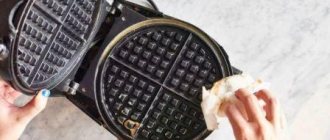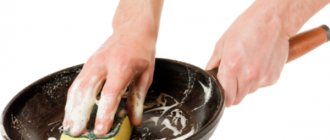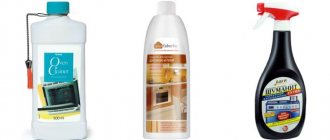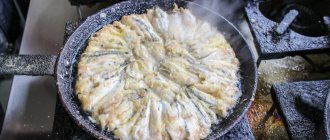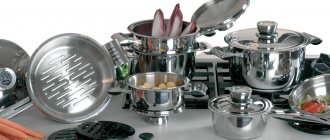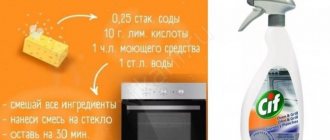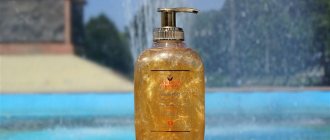/Order/
To be honest, cleaning a frying pan from carbon deposits and grease can often be very difficult, especially if it is old or badly burnt. But there is good news: you can still deal with most persistent stains with cheap products that you already have at home (or at least make the task significantly easier). The main thing is to choose the method that is suitable for your frying pan. After all, what a cast-iron saucepan will save, a Teflon pancake maker can hopelessly destroy.
In this article you can find almost all traditional and non-standard methods of cleaning frying pans of any type: cast iron, stainless steel, aluminum with non-stick coating (Teflon, enamel, ceramic, marble) and without it. Just choose the recipe that suits you.
How to choose a method for cleaning a frying pan
To properly clean an old frying pan from carbon deposits, first of all, determine what material it is made of. There are cast iron, aluminum and stainless steel frying pans.
In modern industry, cookware with non-stick coating is gaining increasing popularity. She requires careful and delicate care. Such pans are easy to clean, as their surface protects against the formation of carbon deposits on the dishes.
Safety rules for cleaning dishes from carbon deposits and grease
Cleaning dishes requires compliance with safety precautions:
- When working with chemicals, wear gloves and maybe a face mask;
- During the procedure, it is worth opening the window;
- There should be no animals or children in the kitchen;
- At the end of cleaning, all working surfaces must be washed with soap.
The most obvious and effective means of prevention is the timely removal of greasy stains.
Traditional methods against soot in a frying pan
At home, you can use improvised means that are always available in the kitchen. They safely allow you to clean the inside of the frying pan from carbon deposits.
The prepared table will help determine contraindications for using a particular cleaning product for a specific type of frying pan.
Citric acid, vinegar and washing powder
The method involves use with different approaches.
- When the deposits on the dishes are fresh enough, lemon will do its job perfectly. To do this, you need to place the frying pan in the solution (for 1 liter of water - 1 tablespoon of citric acid). Boil for 20-30 minutes. Rinse with warm water.
- You can add vinegar to the prepared solution. Boil the frying pan in this water for 10-15 minutes. Turn off the heat and clean the dishes with a sponge after 2 hours. Then you can add washing powder to the same composition, bring to a boil, and leave for another 1 hour. Rinse with warm water.
- If there are damages and scratches on the frying pan, it is better not to boil the dishes. After each time of use, it is enough to wipe with a sponge soaked in a weak solution of acetic acid.
Important! The method cannot be used to clean aluminum pans, as well as dishes with damaged coating.
Coca Cola
The carbonated drink has long established itself as an excellent means for cleaning pots and pans. Just pour Coca-Cola into a bowl, bring to a boil and after 15 minutes turn off the stove. Leave it like this until it cools completely.
Important! The method is ideal for cleaning cast iron and stainless steel cookware.
Mustard powder
In Soviet times, mustard was valued as the most effective means of removing fat. To do this, a frying pan or saucepan was heated over a fire. They covered the bottom with mustard powder and scrubbed it off. After 20 minutes, wash off with water.
If it was not possible to wash it the first time, then the dishes were soaked in mustard solution for 40 minutes. Then washed again.
Cleaning and boiling in salt solution
Cleaning with salt is suitable for almost any dishware.
- Salt is poured onto the bottom of the frying pan (can be used together with sand).
- Lightly moisten and let stand for at least 2 hours. Sponge.
- If this does not help, you must immediately add water and boil. Perhaps this option will be more effective.
For your information! Do not apply to Teflon and ceramic cookware.
Using hydrogen peroxide, baking soda or soda ash
- Baking soda will help clean the pan from years of carbon deposits. Place a frying pan in a container with boiling water and soda. Reduce the heat to low and leave for 30 minutes. Then turn it off. Let it sit for another half hour. The dishes are washed with warm water.
- If this method does not help, add hydrogen peroxide and a few drops of dishwashing detergent to the soda solution. Leave for another 30-45 minutes. Rinse thoroughly with water several times. The method is actively used for cleaning non-stick frying pans.
Another option (always effective) is when glue and soap are added to the soda solution (see recipe above).
Ammonia and borax for cleaning cast iron surfaces
If food is badly burnt, the prepared solution will help to cope with the soot.
- For 300 ml of water, take ammonia and 12 g of borax.
- This mixture is poured onto the burnt surface.
- After 1 hour, the liquid is drained, the carbon deposits should easily come away from the surface.
- Kitchen utensils are washed and wiped.
Gels and creams
The most concentrated professional products are produced in the form of gels and creams, which are designed for quick and effective cleaning of pans from fatty deposits of any complexity.
Gel for removing fat deposits.
They can be applied outside or inside the surface of the frying pan with gloved hands or a special brush. Fat, which loves to stick to metal, will literally dissolve before your eyes, leaving residue that needs to be washed off with plain water.
Removing carbon deposits from a frying pan using household chemicals
It is advisable to choose a dish cleaning product that does not contain abrasive substances. It is better to use household chemicals to clean the outside of the frying pan. To clean the inside of the dishes, it is safer to use folk remedies.
- Schumannite is one of the most powerful grease cleaners. Contains alkali. Copes with even the most stubborn stains on cast iron, enameled and metal products.
- "DazhBo" is a washing liquid suitable for cleaning any surface.
- "Easywork" - copes well with any dirt.
- "Unicum" is a universal cream for cleaning dishes. It has a pungent odor, but is capable of cleaning even the most multi-layered deposits in 2 minutes.
- Frosch is a plant-based cleaner. Has a convenient sprayer. It is in great demand among housewives.
The use of any chemical means compliance with safety measures. Therefore, before you start cleaning dishes with a chemical composition, you must wear rubber gloves. If the procedure is carried out at home, you should open a window or vent in the kitchen.
Use of purchased funds
You can buy kitchen utensil cleaning products at a household chemical store. When choosing a product, it is important not only to take into account the recommendations of other housewives, but also:
- study the composition - it is desirable that the product does not contain abrasive substances, and stainless steel frying pans are also “afraid” of ammonia and chlorine;
- pay attention to the scope of application - products for aluminum frying pans may not be suitable for products with Teflon coating.
The choice of cleaning product is individual, however, judging by the reviews, the following have proven themselves well:
- "Domestos-cream";
- "Sanita-gel";
- "Antinagar";
- "Milam";
- Kiilto.
Some housewives use oven cleaners to restore the cleanliness of their pans; Schumanit and Amway are most often mentioned. The products are applied for 15-20 minutes over contaminated areas, then, along with carbon deposits and grease, are removed with a regular detergent.
Recommendations from experts
Manufacturers of cookware recommend adhering to rules that help extend the life of the frying pan. It is important to follow preventive measures that prevent further contamination.
- When cooking and stirring food in a frying pan, you must use a wooden or plastic spatula.
- Use cleaning powders, scratching sponges, and scrapers as little as possible. This will prevent scratches on the inside of the pan.
- If the frying pan is often washed in the dishwasher, then you must clean it by hand once a month. In this case, you can easily notice the appearance of soot, which can be easily eliminated at the initial stage of its manifestation.
- Melamine sponges are well suited for cleaning ceramic products and enamel dishes. But they can only clean the outside.
- An aluminum frying pan should never be rubbed with an iron sponge. The damaged surface quickly oxidizes and the oxide gets into the food. Which will negatively affect human health.
- Baking soda or coarse salt helps get rid of rust on an old frying pan. After washing, be sure to heat the dishes so that the food does not burn.
Prevention
It is easier to protect the frying pan than to subsequently remove a thick layer of carbon deposits. To make your dishes shine, follow these simple rules:
- Do not overheat an empty pan.
- Clean pans immediately after cooking.
- Regularly (once every 7-10 days) remove fat from the outside - removing a thin layer is easier than old growths.
- Use only delicate (wooden, silicone, plastic) spatulas, do not scratch with metal spoons or knives.
Important! The coating of cast iron cookware should be renewed from time to time. To do this, wash the frying pan thoroughly and grease it on all sides with sunflower oil. “Bake” in the oven at 200 degrees for 60 minutes and then let cool. Rinse with hot water.
Modern means and proven tricks of housewives allow you to remove carbon deposits from a frying pan in a matter of hours. But to enjoy cooking every day, take care of the cleanliness of your kitchen utensils regularly.
Activated carbon
Activated carbon is another folk remedy that can cleanse the inside and outside of fresh and old clots of fat.
Activated carbon
The pan is soaked in water, a large amount of active carbon is applied to the oil surface, after which the pan is left for a long period of time.
It is advisable to leave the pan with activated carbon overnight.
Salt
Suitable for materials: aluminum, enamel, ceramics, cast iron
Type of soot: porridge, pasta, jam, sugar.
Instructions:
- Fill the pot or pan with water and let it sit for 0.5-1 hour.
- Cover the soot with salt so that it covers all dirty areas.
- Let stand for 2-3 hours.
- Clean with a sponge.
Do not pour cold liquid into hot enamel cookware - this will lead to microcracks and damage to the coating. Wait until it cools down.
Soda-salt mixture
Suitable for materials: cast iron, enamel.
Type of soot: porridge, sugar, pasta, milk, jam.
Instructions:
- In a separate container, mix 2 tbsp. spoons of table salt, baking soda and 100 ml of water.
- Apply the resulting mixture to dirty areas, cover with a lid and let sit for 24 hours.
- Rinse off the soda-salt mixture and add water.
- Boil for 0.5 hours.
- Allow to cool, rinse with traditional means.
Washing a badly burnt enamel pan - video
What is important to know about non-stick coating
A non-stick coating is the application of a special coating to a frying pan, most often an aluminum one, that is resistant to temperature changes, which is easy to wash and clean, and, thanks to its structure, protects food from burning and sticking to the bottom. The formulas of such coatings are constantly being improved and refined, depending on the identified deficiencies and problems.
Types of coverage:
- Ceralon ceramic coating is reliable, environmentally friendly and safe. However, it does not like sudden changes in temperature. And try not to drop the dishes - chips and cracks may appear. In addition to these features, this is one of the best coating options, and also quite economical.
Ceramics heats up very quickly and retains heat well.
- Teflon coating Teflon is the most common. It is polytetrafluoroethylene. Very convenient, but does not like using metal objects - scratches appear and quality deteriorates. There were rumors that when heated it releases harmful substances - but studies have not confirmed this.
The substance, discovered by chance, is today used in various fields of production.
Important! Still, buy Teflon cookware from trusted manufacturers, since they are the ones who conduct research and improve technology. Unfortunately, the market is flooded with fake cookware, especially Tefal frying pans. Buy from trusted stores and do not forget that good quality tableware cannot be cheap.
- Granite non-stick coating Granite is usually Teflon, supplemented with granite chips. This makes it more resistant to damage from metal objects, and as a result, more durable.
Granite coating does not separate from the product when exposed to high temperatures
- Marble coating is most often also Teflon with the inclusion of marble chips. Makes dishes visually more attractive, and the coating more stable and safe.
The great advantage is the elimination of soot on kitchen utensils and the high strength of the surface layer.
- Whitford QuanTanium titanium coating is a multi-layer coating reinforced with titanium. The most durable and stable, suitable for use on all types of slabs.
Whitford's QuanTanium® non-stick coating is today one of the leaders in its class of coatings in terms of service life, reliability, strength and safety for humans.
What features does non-stick coating have?
The non-stick coating makes the bottom and walls of the cookware thicker, which improves their heat transfer and allows you to spend less energy on cooking. In addition, when preparing food, you can use a minimum of oil or fat, which allows you to preserve vitamins and nutrients in the food.
Pans with such a coating last longer, are easier to cook with, and are not demanding to maintain.
One of the leaders in the market for such tableware since 1956 is the Tefal company. One of the patented inventions is the famous Spot Point - a red circle in the center of the frying pan. It shows the optimal heating temperature of the frying pan, becoming a solid bright red color.
Teflon is a chemical available in powder or aqueous solution form.
Vinegar
Suitable for materials: aluminum, enamel, ceramics, cast iron, stainless steel.
Type of burnt product: jam, sugar, porridge, milk.
See also: How to beat meat if you don’t have a special hammer: 6 simple ideas
Instructions:
- Pour table vinegar over the contaminated areas.
- Cover and let stand for 1.5-2 hours.
- Clean using traditional methods.
Instead of vinegar, use citric acid or freshly squeezed lemon juice, but their effect will be less pronounced. This method also helps well against dark carbon deposits on the outside.
